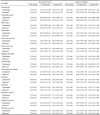1. Lee HS, Kwon SO, Yon M, Kim D, Lee JY, Nam J, et al. Dietary total sugar intake of Koreans: based on the Korea National Health and Nutrition Examination Survey (KNHANES), 2008-2011. J Nutr Health. 2014; 47(4):268–276.

2. Arria AM, Bugbee BA, Caldeira KM, Vincent KB. Evidence and knowledge gaps for the association between energy drink use and high-risk behaviors among adolescents and young adults. Nutr Rev. 2014; 72 Suppl 1:87–97.

3. Ministry of Food and Drug Safety. Study of establishment of recommended daily allowance for caffeine. Cheongju: Ministry of Food and Drug Safety;2007. p. 136–158.
4. Yang YM, Huh W, Jeong E, Lee JJ, Choi EJ. An analysis of consumption patterns of high-caffeinated energy drinks and adverse effects by surveys from students at middle and high schools in Korea. Yakhak Hoeji. 2014; 58(6):387–396.
5. James JE, Baldursdottir B, Johannsdottir KR, Valdimarsdottir HB, Sigfusdottir ID. Adolescent habitual caffeine consumption and hemodynamic reactivity during rest, psychosocial stress, and recovery. J Psychosom Res. 2018; 110:16–23.

6. Sanchis-Gomar F, Pareja-Galeano H, Cervellin G, Lippi G, Earnest CP. Energy drink overconsumption in adolescents: implications for arrhythmias and other cardiovascular events. Can J Cardiol. 2015; 31(5):572–575.

7. Harris JL, Munsell CR. Energy drinks and adolescents: what’s the harm? Nutr Rev. 2015; 73(4):247–257.

8. Ryu SH. Energy drink consumption status and associated factors among male and female high school students in Deajon area. Korean J Food Nutr. 2016; 29(6):899–910.

9. Park EJ, Kim SY. Caffeinated food consumption patterns and level among high school students in Yongin region. J Korean Soc Food Sci Nutr. 2017; 46(9):1128–1136.
10. Park SH, Lee SH, Chang KJ. Intake-related factors and educational needs regarding energy drinks in female high school students in the Incheon area. J Nutr Health. 2017; 50(5):460–471.

11. Ministry of Education, Ministry of Health & Welfare, Korea Centers for Disease Control and Prevention. Korea youth risk behavior web-based survey [Internet]. Sejong: Ministry of Education, Ministry of Health & Welfare, Korea Centers for Disease Control and Prevention;2019. Accessed Jun 5, 2019. Available from:
https://www.cdc.go.kr/yhs/home.jsp?id=m03_05.
12. Korea Centers for Disease Control and Prevention. 2017 Korean national growth chart [Internet]. Cheongju: Korea Centers for Disease Control and Prevention;2017. Accessed Jun 12, 2019. Available from:
https://knhanes.cdc.go.kr/knhanes/sub08/sub08_01.do.
13. Yoo HS, Sim KH. Survey on the high-caffeine energy drink consumption status of university students in Seoul. J East Asian Soc Diet Life. 2014; 24(3):407–420.

14. Kim TY, Kim SM, Kim JY, Im JY, Yu H, Han YH, et al. Awareness and consumption of energy drinks and associated factors among college students in Cheongju. Korean J Community Nutr. 2018; 23(1):60–72.

15. Jin MJ, Yoon CH, Ko HJ, Kim HM, Kim AS, Moon HN, et al. The relationship of caffeine intake with depression, anxiety, stress, and sleep in Korean adolescents. Korean J Fam Med. 2016; 37(2):111–116.

16. National Institute of Food and Drug Safety Evaluation. Sugar database compilation for commonly consumed foods. Cheongju: National Institute of Food and Drug Safety Evaluation;2015. p. 226–236.
17. Bernabé E, Vehkalahti MM, Sheiham A, Aromaa A, Suominen AL. Sugar-sweetened beverage and dental caries in adult: a 4-year prospective study. J Dent. 2014; 42(8):952–958.
18. Richelsen B. Sugar-sweetened beverages and cardio-metabolic disease risks. Curr Opin Clin Nutr Metab Care. 2013; 16(4):478–484.

19. Lien L, Lien N, Heyerdahl S, Thoresen M, Bjertness E. Consumption of soft drinks and hyperactivity, mental distress, and conduct problems among adolescents in Oslo, Norway. Am J Public Health. 2006; 96(10):1815–1820.

20. World Health Organization (WHO). WHO Technical Report Series 916: Diet, nutrition and the prevention of chronic disease. Geneva: WHO;2013. p. 57–60.
21. Keast RS, Swinburn BA, Sayompark D, Whitelock S, Riddell LJ. Caffeine increases sugar-sweetened beverage consumption in a free-living population: a randomised controlled trial. Br J Nutr. 2015; 113(2):366–371.

22. Libuda L, Alexy U, Buyken AE, Sichert-Hellert W, Stehle P, Kersting M. Consumption of sugar-sweetened beverages and its association with nutrient intakes and diet quality in German children and adolescents. Br J Nutr. 2009; 101(10):1549–1557.

23. Lim YK. The effects of caffeinated beverage intake on serum iron(Fe) and total iron binding capacity(TIBC). Korean Association of Addiction Crime Review. 2017; 7(1):93–112.
24. Lim SA, Rho SN. Micro mineral responses to caffeine in serum and urine of healthy young females. Korean J Nutr. 1993; 26(9):1118–1128.
25. Hong KJ, Lee JW, Park MS, Cho YS. A study on the promotion of adolescents milk consumption (I): milk preference and intake pattern of urban adolescents. J Korean Diet Assoc. 2007; 13(1):61–72.
26. Utter J, Denny S, Teevale T, Sheridan J. Energy drink consumption among New Zealand adolescents: association with mental health, health risk behaviours and body size. J Paediatr Child Health. 2018; 54(3):279–283.
27. Korea Consumer Agency. Survey on Safety of Energy Drink. Eumseong: The Consumer Safety Center;2013. p. 61–63.
28. An SM, Park JS, Kim SH. Effect of energy drink dose on exercise capacity, heart rate recovery and heart rate variability after high-intensity exercise. J Exerc Nutrition Biochem. 2014; 18(1):31–39.

29. Aepli A, Kurth S, Tesler N, Jenni OG, Huber R. Caffeine consuming children and adolescents show altered sleep behavior and deep sleep. Brain Sci. 2015; 5(4):441–455.









 PDF
PDF ePub
ePub Citation
Citation Print
Print




 XML Download
XML Download